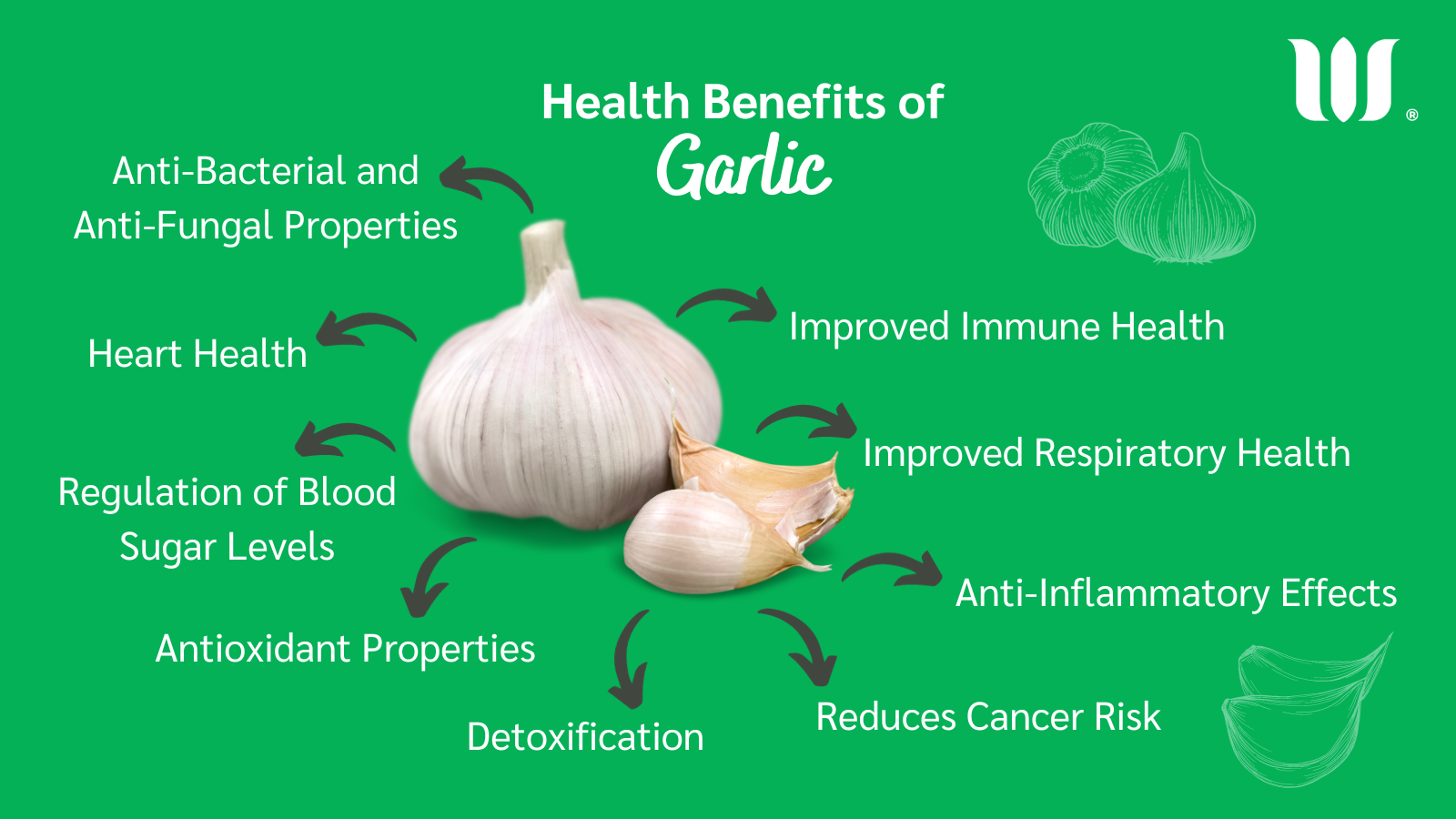 Bookmark
Bookmark Garlic for Digestive Health: Harnessing Nature’s Remedy for Gut Wellness
Garlic for Digestive Health: Harnessing Nature’s Remedy for Gut Wellness
In the world of wholistic health, garlic has an impressive reputation for being known not only as a culinary ingredient but also for the myriad health benefits it offers. Known scientifically as Allium sativum, garlic is a bulbous plant that belongs to the onion family and is native to Central Asia. It has been a staple in traditional medicine for centuries, such as using garlic for digestive health, and is known to help improve overall well-being.
As patients embark on their wholistic health journey, having a firm understanding of the benefits of garlic consumption becomes pivotal in enhancing their wellness and vitality.
Nutritional Composition of Garlic
Garlic, in addition to being a sought-after plant for elevating meals, stands out for its impressive nutritional composition. It’s nutrient-rich, offering a vast array of essential vitamins, minerals, and bioactive compounds.
One of the key components of garlic’s nutritional profile is allicin, a sulfuric compound responsible for its strong aroma and numerous health benefits. In addition to allicin, garlic is a rich source of manganese, vitamin C, vitamin B6, and selenium. Each of these nutrients offers unique benefits that lend support to many health conditions.
For example, manganese plays a crucial role in bone health and blood clotting and is involved in glucose, carbohydrate, and lipid metabolism. Vitamin C, well-known for its booster antioxidant and immune-supportive functions, further complements the immune-supporting properties of garlic. Meanwhile, vitamin B6 is essential for maintaining healthy brain function and general cellular metabolism.
This helpful blend of nutrients makes garlic consumption a valuable addition to a balanced diet, supporting not only the immune system but also aiding in cardiovascular health and general well-being. Garlic also contains small amounts of other important nutrients like fiber, which aids digestion and promotes gut health.
Raw Garlic vs. Fresh Garlic
Both raw and fresh garlic are nutritional powerhouses. Each offers a distinct range of health benefits that cater to different preferences and needs.
Raw garlic, when consumed in its pure form, retains its maximum potency of allicin, a sulfur compound known for its immune-boosting and antimicrobial properties. This makes raw garlic a great option for those looking for robust immune system support. Additionally, raw garlic is believed to have potential cardiovascular benefits, as human studies suggest it may help lower blood pressure and cholesterol levels.
Fresh garlic, when cooked or processed, still maintains a considerable portion of its nutritional value while also being milder in flavor. Additionally, fresh garlic can be a more palatable option for those who wish to avoid the intense taste of raw garlic.
It’s important to note that cooking garlic doesn’t necessarily eliminate its health benefits. Instead, it modifies its chemical composition, making certain nutrients more accessible to the body. This enables individuals to enjoy the culinary benefits of garlic in various dishes while still reaping the rewards of the health benefits that associate with the consumption of garlic.
Whether consuming raw or fresh garlic or taking garlic supplements, garlic intake is both flavorful and helpful to incorporate into an individual’s diet.
Is Garlic Good for Digestive Health?
In the pursuit of wholistic well-being, understanding the role of garlic in digestive health adds yet another compelling reason for dietary inclusion. Garlic can play a key role in maintaining a healthy gut microbiome by optimizing nutrient absorption and improving digestive health. Its anti-inflammatory properties contribute to a soothing effect on the digestive tract, which may help prevent discomfort for individuals prone to digestive issues.
Garlic also contains several essential compounds that contribute to a healthy and well-functioning digestive system. One notable compound is allicin, the sulfuric compound responsible for garlic’s distinct taste and aroma. Allicin, with its antimicrobial properties, not only acts as an immune booster but is also useful in maintaining a balanced gut flora by combating harmful bacteria.
Another positive component garlic offers is a moderate amount of fiber, which helps aid in digestive health. Fiber promotes regular bowel movements, helps prevent constipation, supports the growth of beneficial bacteria in the gut, and prevents bad bacteria from invading the gastrointestinal tract. By incorporating garlic consumption into a diet, individuals can leverage its myriad digestive benefits.
The Role of Garlic’s Fructans and Organosulfur Compounds
Fructans are complex carbohydrates made up of fructose molecules that link together. These compounds are naturally present in various plants like wheat, onions, and artichokes, and can contribute to digestive issues for some people due to their fermentability in the gut.
Organosulfur compounds, on the other hand, are organic molecules containing sulfur atoms that bond to carbon atoms, forming a unique class of chemical compounds. These compounds are widely distributed in nature and are known for their intricate roles, ranging from contributing to the characteristic flavors and aromas of garlic and onions to exhibiting therapeutic effects in certain medicinal plants.
Garlic’s fructans act like food for good bacteria in the gut and organosulfur compounds help fight off harmful bacteria. Together, both support gut health by promoting good bacteria growth and keeping bad bacteria at bay. This can lead to positive effects on lipid metabolism, insulin sensitivity, liver function, and the overall balance of gut bacteria.
Garlic’s Role in Reducing Gastric Cancer Risk
A study investigated the relationship between garlic intake and the risk of gastrointestinal cancer, focusing on gastric and colorectal cancers, which are prevalent across the globe. The findings reveal a clear correlation between garlic intake and a reduced risk of both cancer conditions.
Specifically, garlic consumption was linked to a 35% reduction in the risk of gastric cancer and 25% reduction in the risk of colorectal cancer. |
The study highlights four main organic sulfides in garlic—diallyl disulfide, diallyl trisulfide, S-allylmercaptocysteine , and allicin—as potential contributors to the regulation of tumor cell processes. Upon reviewing these findings, the researchers hypothesize these active ingredients in garlic may act on multiple pathways and in turn, reduce the risk of gastrointestinal tumors.
The study’s results provide compelling support acknowledging the role garlic intake plays in reducing gastric cancer risk, particularly gastric and colorectal cancers.
Other Proven Health Benefits of Garlic
In addition to digestive health benefits, garlic is associated with a large range of health benefits. Keep in mind individual responses may vary, however, several proven advantages include:
Heart Health
Garlic has been linked to improving heart health by reducing blood pressure and lowering cholesterol levels. It may help in preventing heart disorders.
Antioxidant Properties
Garlic contains antioxidants that help combat oxidative stress and free radicals in the body, potentially reducing the risk of common diseases such as cancer, cardiovascular and metabolic disorders, blood pressure, and diabetes.
Anti-Inflammatory Effects
The anti-inflammatory properties of garlic may contribute to reducing inflammation in the body, which impacts various chronic conditions.
Improved Immune Health
Garlic has immune-boosting properties that may enhance the body’s defense mechanisms, helping to fend off illnesses and infections. Recent studies have shown that those who consume garlic are less prone to catching the common cold.
Reduces Cancer Risk
Some studies suggest that garlic consumption may be associated with a reduced risk of certain cancers, particularly those of the digestive system, as well as breast cancer, pancreatic cancer, and esophageal cancer.
Improved Respiratory Health
Garlic has been traditionally used to alleviate respiratory issues. It may help in reducing the severity and duration of common colds and other respiratory infections.
Detoxification
Garlic may assist in detoxifying the body by supporting the liver in eliminating harmful toxins.
Anti-Bacterial and Anti-Fungal Properties
Garlic has natural anti–bacterial and anti–fungal properties, which may help in combating infections.
Regulation of Blood Sugar Levels
Some studies suggest that garlic may have a positive impact on blood sugar levels, making it potentially beneficial for diabetes patients or those at risk.

The History of Garlic
The history of garlic is rich and spans thousands of years, having long-standing importance in various cultures and civilizations. Here’s a brief overview of the history of garlic:
Origins and Ancient Cultivation
Garlic is believed to have originated in Central Asia, and it has been cultivated for over 5,000 years. Archaeological evidence suggests that garlic was consumed in ancient civilizations such as Egypt, Mesopotamia, and the Indus Valley.
Ancient Egypt
Garlic had a sacred significance in ancient Egypt. It was not only consumed as food, but it was also fed to slaves to make them stronger and placed in the tombs of pharaohs. Garlic was highly valued for its perceived medicinal properties and was considered a symbol of protection.
Ancient Greece and Rome
Garlic found its way into ancient Greek and Roman cultures. It was consumed by soldiers and athletes for strength and endurance. Hippocrates, known as the father of medicine, acknowledged the therapeutic properties of garlic and used it to treat various conditions.
Medieval and Renaissance Periods
Garlic continued to be a staple in medieval Europe, where it was believed to offer protection against evil spirits and was even used as protection against the plague. During the Renaissance, garlic’s medicinal properties continued to gain recognition, and it was used to treat ailments ranging from infections to digestive issues.
Middle East and Asia
In the Middle East, garlic has been a crucial ingredient in cuisine for centuries. It is one of the key ingredients in popular dishes like hummus and various kebabs. In Asia, especially in countries like China and India, garlic has been used both as a culinary spice and for its medicinal benefits.
Colonial America
European settlers brought garlic to the Americas during the colonial period. It became a common ingredient in American cooking, particularly in the cuisines of various immigrant communities.
Modern Times
Garlic continues to remain a diet staple today, becoming a common ingredient found in myriad cuisines. Its versatility and distinct flavor make it a favorite ingredient for many. Additionally, garlic’s potential to help numerous health conditions continues to make it the subject in many scientific research studies.
Conclusion
Garlic’s multifaceted role in wholistic health has continued to gain traction for thousands of years, reflecting its significance across diverse cultures for its advantageous potential effects.
From its ancient origins in Central Asia to its sacred stature in Egyptian tombs, garlic has evolved from a symbol of strength to a staple in numerous human studies. Whether in the form of garlic supplements or the more potent raw form, its nutritional richness will continue to position it as a key resource for combatting various health conditions and reducing the risk of cancers.
Did you know Wholistic Matters is powered by Standard Process? Click to learn more.











